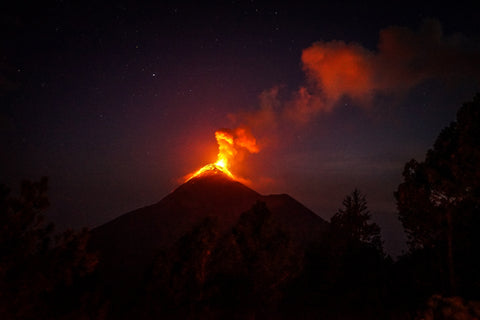
The Ring of Fire is well-known worldwide for its volcanic activity. While the rate of the eruptions in it isn’t increasing, the damage they cause is. This is largely due to the fact that the Earth’s population is growing, and larger numbers of people have to settle in close proximity to volcanoes. Thus, eruptions result in more losses in property and impose higher risks to the lives of the locals.
Find out in which areas the Ring of Fire volcanic activity are the highest in modern days and what were the biggest eruptions in its history.
What Is the Ring of Fire?

The Ring of Fire, also known as the Circum-Pacific Belt, is a 24,900 miles long string of active volcanoes. There are more than 450 volcanoes within the Ring of Fire, which sums up to 75% of the global number of volcanoes contributing to 90% of global earthquakes.
The borders of the Ring of Fire can be traced along multiple tectonic plates, including:
- Pacific Plate
- Juan de Fuca Plate
- Cocos Plate
- Indian-Australian Plate
- Nazca Plate
- North American Plate
- Philippine Plate
Read ahead to find out why this vast area is so densely covered with volcanoes, some of which are currently active.
Why Are There So Many Active Volcanoes Along the Ring of Fire?

A large number of active volcanoes on the Ring of Fire is the result of tectonic plates movement. The plates overlap at convergent boundaries, or subduction zones. When the plate below is pushed down by the plate above, the rock melts and transforms to magma. The accumulation of magma close to the Earth’s surface creates the conditions for volcanic activity along the Ring of Fire.
However, the border between Pacific and North American Plates is an exception since the plates there move sideways. This creates tension in the Earth’s crust that, when released, creates earthquakes.
The Biggest Volcanic Eruptions Within the Ring of Fire

The Ring of Fire volcanoes have produced many powerful eruptions, the biggest ones being the following:
While the major Ring of Fire eruptions were recorded mainly in the 19th and 20th centuries, this area is still creating big volcanic events.
Current Ring of Fire Activity

Most of the volcanoes on the Ring of Fire that are currently active are located on its western edge, specifically from Kamchatka in Russia, through Japan and Southeast Asia, up to New Zealand.
The most active volcanoes in this area at the moment are:
- Mount Ruapehu in New Zealand causes minor eruptions on a yearly basis. It also creates big eruptions approximately every 50 years, with the latest major one registered on September 25, 2007.
- Popocatépetl in Mexico, the history of which features 15 eruptions since 1519. Since this volcano is located close to Mexico City and Puebla, it puts the lives of over 20 million local inhabitants at risk.
- Mount Fuji is not only the tallest and most famous mountain in Japan but also an active volcano. While its latest eruption was in 1707, the recent earthquakes happening in the East of the country may have put it in a critical state, as it sits at a junction of three tectonic plates (the Amur Plate, Okhotsk Plate, and Philippine Plate).
The eastern part of the Ring of Fire also has active volcanoes, specifically in the Trans-Mexican Volcanic Belt, the Aleutian Islands, the Cascade Mountains, and the Andes Mountains.
Will the Ring of Fire’s Volcanoes Erupt in the Near Future?

According to some volcanologists, the two Pacific Ring of Fire active volcanoes most likely to erupt in 2022 are:
- Taal Volcano, Philippines
- Mauna Loa, Hawaii
Another volcano that caused havoc in December 2021, Hunga-Tonga-Ha'apai, is also showing signs of another possible eruption, according to NASA.
With that said, it’s vital to constantly monitor the authorities’ forecasts regarding the potential Ring of Fire volcanic activity for local residents and travelers planning to visit the area to stay safe and prepared.
Update (2/2023): The Mauna Loa volcano in Hawaii erupted for almost 2 weeks in November 2022. Get more information on the eruption and tips for traveling to an area with high volcanic activity here.






